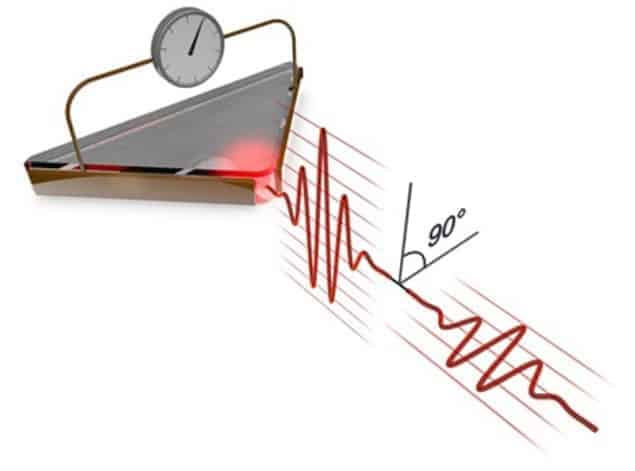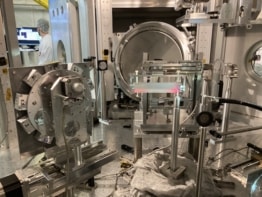
An international team of physicists has shown that an extremely short pulse of light can be used to convert an insulator into a metal, allowing an electrical current to be switched on and off for intervals as short as a few femtoseconds. The technology could be used to create transistors that are 10,000 times faster than those available today. The effect could also form the basis of a cheap and easy way of characterizing ultrafast laser pulses – something that is currently very expensive to do.
The work is reported in two papers by the team that appear in the journal Nature. In the first paper, Agustin Schiffrin and Ferenc Krausz of the Max Planck Institute for Quantum Optics in Germany, Mark Stockman of Georgia State University in the US and colleagues describe what happens when you fire short yet intense laser pulses at a sample of silicon dioxide.
Silicon dioxide is an insulator with an energy bad gap of about 9 eV separating its valence and conduction bands. In contrast, the band gap in silicon is about 1.1 eV; this means that, in principle, a switch made from silicon dioxide could operate much faster than a conventional silicon switch. The problem, however, is that a silicon-dioxide switch would have to operate at very high electric fields, resulting in a destructive electrical breakdown.
Closing the gap
One way round this problem is to apply a strong electric field for an extremely short time, so that breakdown does not occur. When the field is applied, some of the electron states in the valence band increase in energy while some states in the conduction band decrease. The upshot of this is a significant reduction in the amount of energy required to create a conduction electron and the material becomes an electrical conductor.
The team created this brief electric field using laser pulses that are only 4 fs long – so short that they only contain about 1.5 cycles of an electromagnetic wave. The pulses are fired at a piece of silicon dioxide that has two gold electrodes on its surface. They are aimed at the 50 nm gap between the electrodes and the light is polarized so that its electric field is parallel to the silicon-dioxide surface and oscillating back and forth between the two electrodes (see figure).
Sweeping back and forth
The pulse creates conduction electrons, which feel the force of the pulse’s electric field. These are first swept towards one gold electrode and then towards the other as the direction of the field switches. This effect is measured by connecting the two electrodes by an ammeter and measuring the current.
To show that the band-gap modification and current generation were independent processes, the team did a second experiment involving two pulses. One pulse had its electric field running along the gap so it cannot sweep electrons towards the electrodes but can still modify the band structure. The second pulse had its electric field running between the electrodes. The second pulse was set at a much lower intensity, so it was able to sweep conduction electrons but not modify the band structure. As expected, a current was still seen.
While the experiment shows that a semiconductor can be switched to a conductor on a timescale of about 1 fs, it does not give direct evidence that the system reverts back to a semiconductor on a timescale of about 1 fs – something that would be crucial for building circuits that operate on femtosecond timescales.
Confirming femtosecond shutdown
To do this, the team did a second, more complicated experiment that is described in the second paper. This involved measuring the absorption and reflectance of light from a silicon-dioxide sample – which confirmed that the effect is indeed shut down in about 1 fs.
Schiffrin describes the work presented in Nature as a proof of principle that an intense, ultrafast laser pulse can be used to switch a solid-state device. “Now we can fundamentally have a device that works 10,000 times faster than a transistor that can run at 100 GHz,” Stockman adds. In order to explore this possibility, the team is now looking at how it could hook up two switches to make a logic gate. Coupling between devices could be achieved using plasmonics – which involves quantized oscillations of conduction electrons in a material.
While it may be straightforward to create such logic devices in the lab, anyone wanting to make practical commercial devices would first have to create low-cost lasers that can deliver the appropriate pulses. While this would be a significant technological challenge, Schiffrin believes that it should be possible.
In the shorter term, Schiffrin says that the silicon-dioxide and gold structures could prove very useful for characterizing the output of ultrafast lasers – something that currently involves measurements done in an ultrahigh vacuum and using expensive electron spectrometers. Indeed, the team already has a patent on that particularly application, says Schiffrin.


